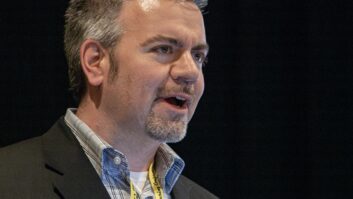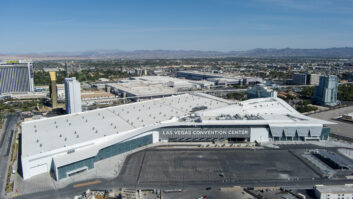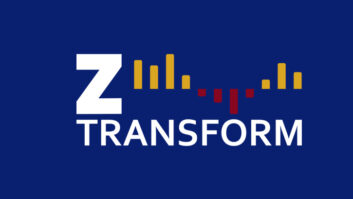(click thumbnail)A gas/electric hybrid Toyota Camry used by WMMM(FM) for station events.BALA CYNWYD, Pa. Many broadcasters are trimming high electric bills by imposing system-wide energy conservation policies for studios, transmitter sites and offices to reduce electricity use. The changes, in turn, also help the environment.
At least one broadcaster has taken extraordinary measures to reduce its so-called “carbon footprint” by adopting green policies, such as using alternative energy vehicles when possible and establishing working groups to explore energy conservation options.
Entercom, which like other broadcasters has a substantial appetite for energy, is being fiscally and environmentally responsible, company officials say, by practicing conservation whenever and wherever possible. The group, which has 120 radio stations in the United States, is aggressively pursuing policies to cut energy consumption.
“We are trying to strike a reasonable balance to keep both costs and our carbon emissions down. As a company, we are looking at not only operating costs but the carbon footprint, which is determined by looking at all energy usage, from natural gas and electrical use to fuel for station vehicles,” said Marty Hadfield, vice president of engineering for Entercom.
Heating, cooling
The broadcaster launched an initiative in 2004 to install overnight and weekend HVAC shutdown and limited cycling systems in general office areas. Entercom also installed passive infrared sensors, which turn on lights in occupied spaces, Hadfield said.
“We’ve also completed converting close to 90 percent of our incandescent tower lighting systems to LEDs, which [results in] a 75 percent reduction in energy consumption. It also yields the advantage of a reduced replacement cycle,” Hadfield said.
With electric bills running in the thousands of dollars for its clusters of stations, the 10 percent reduction in energy as a result of the initiative has been noticeable, he said.
“It’s hard to calculate the cost savings, because energy costs more or less depending on where in the country you are. However, in the Pacific Northwest, we know our carbon footprint is smaller because much of the energy comes from renewable resources like hydroelectric. And in other states we use wind energy when it’s available on the grid,” Hadfield said.
CEO David Field spearheads the energy conservation drive at Entercom. “David has been very keenly involved in energy reduction efforts. But it really is something many of us in the company have adopted as our own. We are looking for ways to lower our global impact and this is a great way to do it,” Hadfield said.
Entercom has circulated suggestions and guidelines for conservation and reduced use of hazardous cleaning materials, Hadfield said.
In Wisconsin, Entercom has partnered with Alliant Energy in a program called “Second Nature.” The program is aimed at businesses in the state to support the growth of clean energy from wind, solar and biomass, said Chris Tarr, Entercom director of engineering for the Milwaukee and Madison, Wis., clusters. Biomass most commonly refers to plant material grown for use as biofuels, such as ethanol.
Alliant purchases wind energy from more than 300 large-scale wind turbines located at 15 wind farms in the upper Midwest. As energy comes into the energy pool from nearby wind farms, it displaces electricity that would otherwise come from sources like coal, natural gas and nuclear, according to the Alliant Energy Web site.
“We can’t get energy directly from the wind farm, so we pay credits to the energy company that go towards purchasing energy from wind farms near Madison to put back on the grid,” Tarr explained. “It’s a back-end deal. They calculate our energy usage and our credits then pay for that much electricity from the wind farm.”
‘Second Nature’
Madison is a environmentally conscious community, Tarr said, a university town with many environmentally active groups. Entercom’s WMMM(FM) even has a “Triple M Green Team” that does a lot of cause marketing. The station heavily promotes Alliant Energy’s “Second Nature” program.
“We have a station vehicle that is a hybrid car that runs on ethanol. Wisconsin is a huge corn-producing state, so that ties in, too,” Tarr said.
The Madison cluster, which includes WMMM, WOLX(FM) and WCHY(FM), has converted to a paperless data and record storage system, put timers on water heaters and unplugged obsolete equipment.
“For instance, we had an AM distortion monitor plugged in and running at the transmitter site. We really didn’t need it on all the time so we unplugged it. We have found that the little things do add up. It really isn’t painful at all,” Tarr said.
Entercom officials acknowledge there is only so much energy conserving that radio stations can do, noting that their facilities need a steady and even flow of electricity to function.
“Unfortunately, solid-state transmitters for FM are almost across the board less efficient per watt output than tube type transmitters,” Hadfield said. “HD Radio in particular is less energy efficient. They need a flatter pass band, so the power handling capability for those transistors is less efficient. We are trying to work with the transmitter manufacturers to see if we could come up with new schemes of modulation techniques, power supply techniques and cooling techniques.”
The company is also looking for efficiencies in cooling their transmitter buildings. At least one transmitter manufacturer, Continental, is producing liquid-cooled tube-type transmitters, Hadfield said, which would help reduce air conditioning demand for the building.
Entercom isn’t the only broadcaster encumbered by high-energy bills and taking steps to conserve and preserve when possible. Officials for Citadel Broadcasting, Cox Radio and Cumulus Media said their respective groups are always looking for ways to be energy and environmentally conscious.
See past articles on energy savings for broadcasters. Go to radioworld.com, click on Tech Tips and scroll to the “Energy Special” articles.













